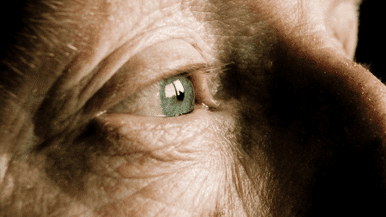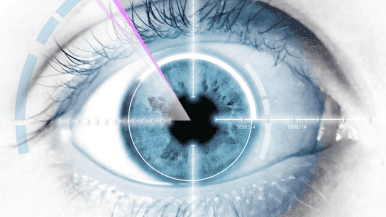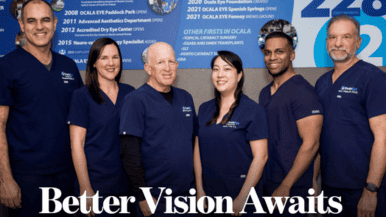- What is refractive lens exchange?
- Why would I need refractive lens exchange?
- What is recovery like from refractive lens surgery?
- Is refractive lens exchange better than LASIK?
- Am I a candidate for refractive lens exchange?
Randy has been a long-time friend to Ocala Eye, having serviced the clinic’s equipment for 24 years. When it came time for his refractive lens exchange, he says, “There was no question in my mind if I had eye surgery or any eye procedures done, that I would come to Ocala Eye.”
What is refractive lens exchange? Clinicians consider it an alternative for patients with refractive errors who may not be eligible for LASIK surgery. Who are the patients like Randy who can benefit from this type of eye surgery? We have answers to help you understand refractive lens exchange.
What Is Refractive Lens Exchange?
Refractive lens exchange is a type of lens replacement surgery that surgically substitutes your eye’s natural clear lens with an artificial intraocular lens (IOL). Refractive lens exchange seeks to eliminate your need for bifocals or reading glasses by surgically correcting your refractive error and bringing your vision into sharper focus.
Randy describes the process as “basically cataract surgery without the cataracts.” He’s not wrong, either; the refractive lens exchange procedure is almost identical to cataract surgery. It looks something like this:
- The patient is given a mild sedative to relax them and numbing eye drops are used to alleviate any discomfort.
- The skin around the eye is thoroughly cleansed. Sterile coverings are draped around the surgical area, and the eye is held open with an eyelid holder to prevent blinking during surgery.
- By using an operating microscope, the doctor creates a tiny opening to the eye.
- An ultrasound gently fragments the natural lens for easy removal.
- Finally, the doctor inserts the new IOL into the eye.
The small eye-opening will close on its own without needing stitches, and patients can go home the same day of the procedure. The entire procedure takes about 15 minutes or less per eye. Patients can have both eyes done about two weeks apart.
If you have refractive lens exchange done, you’ll be amazed to see your vision begin to clear and your eyesight return without the aid of your glasses within just a few days. We should note that this surgery is a permanent replacement for your regular lens; this procedure is designed to last a lifetime. Therefore, there is minimal risk that your vision will regress or deteriorate over time.
Why Would I Need Refractive Lens Exchange?
If you suffer from presbyopia, which is the inability to focus on images that are near your eyes, or hyperopia (farsightedness), refractive lens exchange may help. Typically, we see this surgery used for older patients who are experiencing these conditions as a natural result of their eyes changing over time.
There are three types of IOLs available to treat different vision conditions:
- Monofocal fixed-focal IOLs can provide clear vision close up, intermediate, or far away, but not all at the same time
- Multifocal IOLs offers clear vision at multiple distance ranges
- Accommodating IOLs support clear vision at multiple distances by shifting the position of the lens within the eye
Just like with glasses, there is no one-size-fits-all for your IOL choice. Your eye doctor will recommend the lens that is right for you.
What Is Recovery Like from Refractive Lens Surgery?
 The initial recovery period from refractive lens surgery takes just about a week. It’s a relatively easy procedure with no discomfort and dramatic results.
The initial recovery period from refractive lens surgery takes just about a week. It’s a relatively easy procedure with no discomfort and dramatic results.
Randy says, “For me, recovery was practically painless. There was some irritation, but they keep you well-stocked in eye drops, some for pain management and some just to keep your eyes lubricated.” The numbing anesthetic drops keep patients quite comfortable, and most patients report clearer vision even right after surgery.
However, it could take up to several weeks for the full effects to kick in. During this time, you may notice halos or blurry vision. Your eyes may feel a little scratchy as the healing process kicks in. The eye drops will help with lubrication and any discomfort you may feel. About a week after the surgery, you should be driving and back to work with no problems. Randy says, “I was pretty comfortable throughout the recovery process.”
Is Refractive Lens Exchange Better Than LASIK?
Refractive lens exchange is on just about the same level as LASIK in terms of effectiveness. However, these procedures are used for slightly different reasons. Refractive lens exchange corrects hyperopia, presbyopia, and even early cataracts, while LASIK corrects myopia (near-sightedness), hyperopia, and astigmatism.
Both procedures have contraindications that could point doctors in the direction of using one or the other—or neither, depending upon your situation.
Am I A Candidate for Refractive Lens Exchange?
The best answer to this question is to ask your doctor. Determining which treatment is best for your particular condition is an individualized decision. If you’ve been told you’re not eligible for LASIK because of certain conditions, you may be a candidate for refractive lens exchange.
Randy is living proof of the effectiveness of refractive lens exchange surgery. We are very proud that he entrusted his eyesight to our practice. When asked why he chose Ocala Eye, Randy says, “They do things right.” If you’re seeking better vision, Ocala Eye is standing by to help you have a lifetime of seeing clearly.




